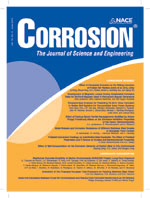
CORROSION
Scope & Guideline
Unveiling Insights for Sustainable Engineering Practices
Introduction
Aims and Scopes
- Corrosion Mechanisms and Processes:
A core focus of the journal is to elucidate the fundamental mechanisms underlying corrosion phenomena, including electrochemical reactions, environmental influences, and material responses. This includes studies on localized corrosion types such as pitting, crevice, and stress corrosion cracking. - Corrosion Mitigation Strategies:
The journal emphasizes research on various corrosion protection methods, including the development and evaluation of coatings, inhibitors, and cathodic protection techniques aimed at extending the service life of materials in corrosive environments. - Material-Specific Corrosion Studies:
Research articles often target specific materials, including metals and alloys, providing insights into their corrosion behavior under diverse conditions such as marine, acidic, or high-temperature environments. - Innovative Testing and Characterization Methods:
The journal promotes the use of advanced experimental and computational techniques for corrosion assessment, including electrochemical methods, imaging techniques, and modeling approaches to predict corrosion rates and mechanisms. - Environmental Impact on Corrosion:
The impact of environmental factors such as temperature, humidity, and chemical composition on corrosion processes is a significant area of exploration, with studies assessing how these factors influence the durability of materials.
Trending and Emerging
- Corrosion in Sustainable and Renewable Energy:
Recent publications increasingly address corrosion challenges in the context of renewable energy technologies, such as solar panels and wind turbines, emphasizing the need for materials that can withstand harsh environmental conditions. - Microbiologically Influenced Corrosion (MIC):
There is a growing emphasis on the study of microbiologically influenced corrosion, particularly in oil and gas pipelines, where microbial activity significantly impacts the integrity of materials. - Advanced Materials and Coatings:
Research on innovative materials, including nanomaterials and high-entropy alloys, and their corrosion resistance is gaining traction. This includes studies on the effectiveness of novel protective coatings. - Machine Learning and Computational Modeling:
The application of machine learning and computational modeling techniques for predicting corrosion behavior and optimizing corrosion mitigation strategies is on the rise, indicating a trend towards data-driven approaches in corrosion research. - Corrosion in Extreme Environments:
Emerging studies focus on corrosion in extreme environments, such as deep-sea and high-pressure conditions, reflecting the industry's need for materials that can perform reliably under such challenges.
Declining or Waning
- Traditional Corrosion Testing Methods:
There seems to be a waning focus on conventional corrosion testing methods that do not incorporate modern analytical techniques. As the field advances, researchers are increasingly favoring innovative, high-throughput testing methodologies that provide more comprehensive data. - Corrosion in Non-Metallic Materials:
Studies specifically targeting corrosion in non-metallic materials have decreased, potentially as a shift towards more pressing issues related to metallic corrosion in structural applications has taken precedence. - Localized Corrosion in Simple Environments:
Research focusing on localized corrosion in straightforward, controlled environments is less frequent, indicating a shift towards more complex and realistic conditions that mimic real-world applications.
Similar Journals

Moroccan Journal of Chemistry
Empowering Chemists with Cutting-Edge Discoveries.Moroccan Journal of Chemistry, published by the University Mohammed Premier Oujda, serves as a pivotal platform for researchers and professionals in the field of chemistry, particularly focusing on diverse and emerging areas within the discipline. Established in 2018, this open-access journal facilitates widespread dissemination of scholarly articles, ensuring that cutting-edge research reaches a global audience. With an ISSN of 2351-812X and categorized in the Q3 quartile for miscellaneous chemistry in 2023, the journal maintains rigorous peer-review standards while fostering an inclusive environment for scientific dialogue. Located in Morocco, it aims to bridge local and international research communities, contributing to the advancement of knowledge in chemistry. As it continues to grow, the Moroccan Journal of Chemistry remains an essential resource for students, educators, and professionals eager to stay abreast of the latest developments in the field.
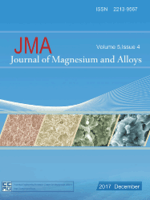
Journal of Magnesium and Alloys
Advancing the Future of Materials ScienceThe Journal of Magnesium and Alloys is a prestigious, peer-reviewed academic publication dedicated to advancing the field of materials science, particularly focusing on magnesium and its alloys. Published by KEAI PUBLISHING LTD since 2013, this Open Access journal enables unrestricted dissemination of research findings, enhancing global collaboration among researchers, professionals, and students. With an ISSN of 2213-9567 and a significant impact factor, it has established itself in the upper quartiles (Q1) of both the Mechanics of Materials and Metals and Alloys categories, ranking #3 out of 176 and #9 out of 398 respectively according to Scopus. The journal aims to provide a forum for the latest advances in the understanding, production, and application of magnesium alloys, fostering innovation and sustainable practices within the materials engineering community. Based in Beijing, China, the journal is committed to bridging gaps in current knowledge and driving future research directions through its high-quality publications.

Analytical & Bioanalytical Electrochemistry
Empowering Researchers with Cutting-edge Electrochemical KnowledgeAnalytical & Bioanalytical Electrochemistry is a pivotal journal dedicated to the advancement of research and innovation in the fields of analytical chemistry and electrochemistry. Published by the University of Tehran, Faculty of Chemistry, Center of Excellence in Electrochemistry, this journal has been contributing to the scientific community since its inception in 2009 and continues to be a critical platform through 2024. With an ISSN of 2008-4226, it focuses on a variety of topics including electrochemical sensors, bioanalytical techniques, and innovative methodologies in electrochemical analysis. Although it currently holds a Q4 quartile ranking in both analytical chemistry and electrochemistry categories, its unique insights and research findings are essential for advancing knowledge and fostering interdisciplinary collaboration within the scientific community. Researchers, professionals, and students engaged in these dynamic fields will find valuable resources and contribute to the ongoing discourse by publishing their work in this journal. We invite you to explore and engage with the diverse content that Analytical & Bioanalytical Electrochemistry offers to enhance your research and professional development.
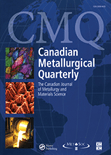
CANADIAN METALLURGICAL QUARTERLY
Elevating Standards in Metallurgy and Engineering.Canadian Metallurgical Quarterly is a prestigious scholarly journal published by Taylor & Francis Ltd, dedicated to the field of metallurgical engineering and materials science. With a rich history dating back to its inception in 1962 and continuing through its most recent publications, this journal serves as a vital platform for the dissemination of innovative research, advancements, and critical reviews in metallurgy, metals, and alloys. Positioned strategically within the academic community, it holds a significant impact factor and is currently rated in the Q2 category for Metals and Alloys, and Q3 in Industrial and Manufacturing Engineering as of 2023, showcasing its authoritative role in these disciplines. Although it does not offer open access, the journal remains widely recognized for its rigorous peer-review process, ensuring that published work adheres to the highest standards of scientific quality. Researchers, professionals, and students alike will find invaluable insights and contributions that drive the field forward.

CORROSION SCIENCE
Leading the charge in corrosion research and technology.CORROSION SCIENCE, published by Pergamon-Elsevier Science Ltd, is a leading journal in the field of corrosion research, recognized for its significant contribution to advancing knowledge in Chemical Engineering, Chemistry, and Materials Science.
With a remarkable impact factor placing it in the Q1 category as of 2023, this journal serves as a crucial platform for researchers, engineers, and practitioners dedicated to the study of corrosion processes, prevention methods, and material degradation. Since its inception in 1961, CORROSION SCIENCE has consistently provided high-quality peer-reviewed articles that explore innovative solutions to corrosion-related challenges, fostering advancements not only in academic research but also in practical applications across various industries. The journal is based in the United Kingdom and is accessible through various academic databases, making it a vital resource for students and professionals seeking to enhance their understanding of corrosion mechanisms and mitigation strategies.
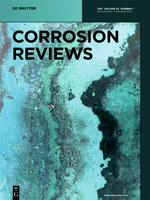
CORROSION REVIEWS
Unlocking Insights into Corrosion PhenomenaCORROSION REVIEWS, published by WALTER DE GRUYTER GMBH in Germany, is a pivotal journal dedicated to advancing the understanding and management of corrosion phenomena across various fields including Chemical Engineering, Chemistry, and Materials Science. With an ISSN of 0334-6005 and an E-ISSN of 2191-0316, this esteemed journal has demonstrated an enduring commitment to scholarly excellence since its inception in 1979, encompassing comprehensive interdisciplinary research outputs and reviews. Ranked in the Q2 category across several disciplines for 2023, and positioned favorably in Scopus rankings—#94 in Chemical Engineering and #145 in Chemistry—it serves as an essential resource for researchers and professionals seeking to enhance their knowledge and application of corrosion science. While the journal does not currently offer open access, its rigorous peer-review process ensures high-quality, credible research publications that contribute significantly to the academic community's efforts in corrosion prevention and policy. Researchers, students, and industry professionals alike will find CORROSION REVIEWS an indispensable tool for staying at the forefront of this critical area of study.
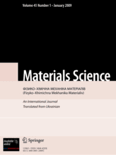
MATERIALS SCIENCE
Unveiling the Science Behind Tomorrow's Materials.MATERIALS SCIENCE, a prominent journal published by SPRINGER, serves as a vital resource for researchers, professionals, and students in the fields of materials science, mechanical engineering, and condensed matter physics. With its ISSN 1068-820X and E-ISSN 1573-885X, this journal has been dedicated to sharing innovative research since its inception in 1993, and it continues to publish groundbreaking findings through 2024. Although it operates as a traditional subscription-based journal, its ranking in the Q3 quartile across multiple scientific categories, including Condensed Matter Physics, Materials Science, Mechanical Engineering, and Mechanics of Materials, signifies its relevance and impact in the academic community. Notably, its Scopus classifications reveal a competitive standing among its peers, ranking within the 25th to 33rd percentiles across various engineering and physics disciplines. The journal remains a key platform for disseminating valuable insights, fostering collaboration, and advancing the understanding of materials science.

Advances in Materials Research-An International Journal
Cultivating Cutting-Edge Research in MaterialsAdvances in Materials Research - An International Journal is an esteemed publication in the field of materials science, spearheaded by TECHNO-PRESS. Established to provide a critical platform for the dissemination of high-quality research, this journal focuses on a broad spectrum of topics, including Biomaterials, Ceramics, Composites, Electronic, Optical, Magnetic Materials, Metals, Alloys, and Polymers. With a commendable impact factor reflecting its substantial contribution to the scientific community, Advances in Materials Research promotes innovative ideas through rigorous peer-review processes and supports the continuous advancement of materials research, particularly in the dynamic environment of South Korea. This journal, which holds impressive rankings across various subfields in the Scopus database, is designed to cater to the needs of researchers, professionals, and students aiming to stay at the cutting edge of materials science. By bridging gaps between theory and application, it invites contributions that push the boundaries of knowledge and technology in diverse material applications.

RUSSIAN JOURNAL OF ELECTROCHEMISTRY
Bridging Theory and Application in ElectrochemistryThe Russian Journal of Electrochemistry, published by Pleiades Publishing Inc, is a reputable scientific resource that caters to the dynamic field of electrochemistry. Since its inception in 1996, this journal has become a platform for the dissemination of cutting-edge research, exploring both foundational studies and innovative applications within electrochemical science. Despite currently holding a Q4 categorization in its field, the journal is dedicated to enhancing its scholarly impact and visibility, reflecting its commitment to fostering advancements in electrochemical technologies. With its ISSN 1023-1935 and E-ISSN 1608-3342, the journal strives to reach a global audience of researchers, professionals, and students alike. Though the journal is not open access, its contents are crucial for anyone looking to stay at the forefront of electrochemical research and developments. The journal's editorial board includes well-respected experts, ensuring that published articles contribute significantly to the scientific community and pave the way for future innovations in the field.
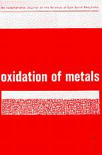
OXIDATION OF METALS
Connecting Scholars in the Quest for Metal IntegrityOXIDATION OF METALS, published by SPRINGER/PLENUM PUBLISHERS, stands as a pivotal journal in the fields of Inorganic Chemistry, Materials Chemistry, and Metals and Alloys. Established in 1969, it has consistently contributed to advancing knowledge and research on the oxidation processes in metals, essential for various industrial applications and theoretical frameworks. With an impact factor that reflects its respected position—ranked Q2 in key scientific categories—this journal facilitates cutting-edge discourse among researchers and practitioners alike. The journal is committed to open access, ensuring that groundbreaking research on metals’ behavior and resistance to oxidation is available to a broader audience, enhancing collaboration and innovation. Spanning over five decades, OXIDATION OF METALS continues to be a crucial resource for scholars and professionals aiming to stay at the forefront of materials science and engineering.